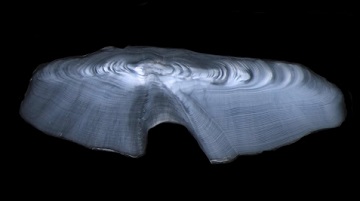A rainy year generally makes for happy trees. They extend not just up, but out, adding a thick layer of new growth. Scientists can pinpoint such years — as well as dry ones, hot ones, and cold ones — in a tree’s rings. That makes the rings great “time machines” for measuring climate over decades or even centuries.
 Cross section of a splitnose rockfish (Sebastes diploproa) otolith. Credit: Dr. Bryan Black, University of Texas Marine Science Institute
Cross section of a splitnose rockfish (Sebastes diploproa) otolith. Credit: Dr. Bryan Black, University of Texas Marine Science InstituteThere are no redwoods or other big trees in the oceans, though, so marine scientists have been a bit limited in assessing the link between climate and life in the sea. But they’re coming up with some “rings” of their own — the shells of some shellfish, and tiny “stones” inside the heads of fish.
The “stones” are otoliths — bone-like structures in a fish’s head. They help the fish stay upright and hear. An otolith adds a distinct layer each year, just as a tree does. So slicing one open reveals the fish’s age.
A study a few years ago in the Pacific Northwest showed there was a correlation between the size of the layers in fish otoliths and the size of tree rings. In other words, the otoliths did just as good a job of recording good years and bad years in the oceans as the tree rings did on land.
Studies have also shown a correlation between the tree rings and the layers of the shells in the Pacific geoduck, which is a type of clam.
That means that marine scientists have their own “tree rings” for measuring changes in the oceans over the decades. And it also demonstrates the influence of climate on life across the Pacific Northwest, from the high Cascades to the continental slope.
This episode of Science and the Sea was made possible by Texas Sea Grant.

